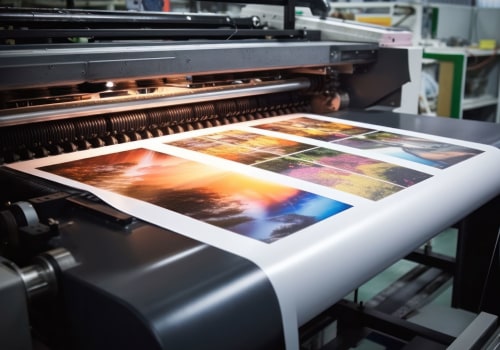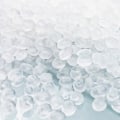Printing materials and ink types are an integral part of the large-format printing process. Knowing the different types of materials and inks used can help you make informed decisions about your printing costs and the quality of your prints. In this comprehensive overview, we'll discuss the various printing materials and inks used in large-format printing, as well as the factors that affect cost. When it comes to large-format printing, there are a wide variety of materials and inks that can be used. Each material and ink type has its own unique properties, which can affect the quality, cost, and longevity of your prints.
From paper to vinyl to canvas, it's important to understand the pros and cons of each material and ink type to ensure you get the best possible results. We'll also discuss how different factors such as printer type, material type, ink type, and other considerations can impact the cost of large-format printing. By understanding these factors, you can make an informed decision about which materials and inks are best suited for your project. Read on to learn more about printing materials and ink types, and how to make the most of your large-format printing project. The first step in understanding printing materials and ink types is to familiarize yourself with the different materials available. Common printing materials include paper, vinyl, canvas, fabric, and specialty media. Each type of material has its own characteristics that can affect the cost of printing, such as weight, durability, color saturation, and more.
Additionally, the type of ink used can also affect the cost. Common ink types include water-based, solvent-based, UV-cured, and eco-solvent inks. Understanding how each type of ink interacts with a given material is essential for achieving the desired result. Next, it's important to consider the cost factors associated with printing materials and ink types. Cost factors can include material type, ink type, number of colors used, resolution, and printing size.
It's also important to consider any additional costs associated with specialty materials or inks that may be necessary for a particular job. Finally, it's important to understand how to properly use the different materials and inks for the best results. Different materials may require different printing processes or techniques. Additionally, some inks may require specific drying or curing methods in order to achieve optimal results. Understanding all of these factors will help ensure that your final product meets your expectations.
Cost Factors
When deciding which printing materials and ink types to use, there are several cost factors to consider.The type of material used can affect the cost of the final product, as can the type of ink chosen. Additionally, the size and complexity of the project may also play a role in the total cost. The type of material used for large format printing can vary greatly, ranging from paper and vinyl to more specialized materials such as polyester or polycarbonate. Each material has its own distinct advantages and disadvantages that can affect the final cost of the project.
For example, paper is generally more affordable but may not be as durable, while polycarbonate is more expensive but offers greater durability. In addition to the type of material used, the type of ink chosen can also have an impact on the total cost. There are a variety of inks available for large format printing, including solvent-based, water-based, UV-curable, and latex inks. Each type of ink has its own unique properties and benefits that can affect the cost of the project.
For instance, solvent-based inks are typically more affordable but may not be as vibrant or long-lasting as other ink types. Finally, the size and complexity of the project can also affect the cost of large format printing. Larger projects may require more materials or ink than smaller ones, so it's important to consider all aspects of the project when making a final decision. Additionally, more complex projects may require additional time or labor to complete, which can add to the overall cost.
Understanding Printing Materials
Printing materials are integral to the large format printing process, as each type of material can affect the cost of the final product.Common materials used for large format printing include paper, vinyl, fabric, and canvas. Here, we will provide an overview of these materials and their characteristics.
Paper
Paper is one of the most common materials used in large format printing. It is lightweight, inexpensive, and can be printed on both sides. The main disadvantage is that it is not very durable, so it is best suited for short-term projects that don’t require a lot of wear and tear.Paper also absorbs ink quickly, making it more prone to smudging than some other materials.
Vinyl
Vinyl is a popular choice for large format printing projects. It is durable, waterproof, and resistant to fading and other damage from exposure to the elements. Vinyl is also versatile – it can be used for indoor or outdoor applications, and it can be cut into any shape or size. The main downside is that it is more expensive than paper.Fabric
Fabric is another popular material for large format printing projects.It is lightweight and versatile, and can be printed on both sides. Fabric prints are also durable, so they can withstand more wear and tear than paper prints. However, fabric prints do require a special inkjet printer.
Canvas
Canvas is a strong, durable material that is ideal for large format printing projects. It has a matte finish that gives prints a unique look, and it can also be stretched to fit frames or other objects.Canvas prints are also very durable, so they are suitable for long-term projects. The main disadvantage is that canvas prints are more expensive than other materials.
Using Materials and Inks Properly
When it comes to large format printing, proper use of materials and inks is essential for achieving the desired results. Different materials and inks are available for different types of jobs, so it's important to understand which ones are suitable for your needs. The first step is to choose the right material.Different materials have different properties, so it's important to select one that will work best for the job at hand. For example, paper is usually used for text-based jobs, while vinyl is often used for outdoor signage. The next step is to select the right ink. Different inks have different properties, and some are better suited for certain materials than others.
For example, solvent-based inks are often used on vinyl, while water-based inks are often used on paper. Once you've selected the right materials and inks, it's important to ensure they are properly applied. This means making sure they are applied evenly and with the right amount of pressure. For example, too much pressure can cause the ink to smudge or bleed, while too little pressure can result in a poor quality print.
Finally, it's important to make sure that the materials and inks are stored properly. This means keeping them in a cool, dry place away from direct sunlight and heat sources. Storing them properly can help ensure they last longer and produce better results.
Ink Types
Ink types are an important factor to consider when printing large format graphics. Inks come in a variety of types and can interact differently with different materials.It is important to understand the different types of ink, as well as the cost factors that may influence their use.
Solvent inks
are the most common type of ink used in large format printing. Solvent inks are made from a blend of solvents, pigments, and resins. They provide excellent durability and resistance to fading and scratching.Additionally, they are often less expensive than other types of inks. However, solvent inks can be more difficult to work with, and should only be used on materials that are specifically designed for solvent inks.
UV-curable inks
are also commonly used for large format printing. These inks are cured using ultraviolet light, which allows them to dry quickly and achieve a glossy finish. UV-curable inks offer excellent durability and scratch resistance, but they can be more expensive than solvent inks.Additionally, the curing process requires specialized equipment, so it should be considered when choosing an ink type.
Latex inks
are a newer type of ink that is becoming increasingly popular for large format printing. Latex inks are water-based and contain no volatile organic compounds (VOCs). They provide superior durability and color accuracy compared to other types of inks, but they can also be more expensive. Additionally, latex inks require specialized materials and equipment to ensure optimal results.Sublimation inks
are primarily used for dye-sublimation printing.Sublimation inks are printed onto a transfer paper and then heated, which causes the ink to vaporize and adhere to the substrate. These inks offer exceptional color accuracy and vibrancy, but they require specialized equipment for optimal results. When choosing an ink type for large format printing, it is important to consider the cost factors involved as well as the desired outcome. Different materials may require different types of ink, so it is important to choose wisely to ensure the best possible result. In conclusion, printing materials and ink types are a critical factor in large format printing projects. By taking the time to understand the different options available, as well as the cost factors associated with them, you can ensure a successful end result.
Additionally, properly using the materials and inks can help to maximize the outcome of your project. With the right knowledge and understanding, you can confidently choose the right materials and inks for your large format printing project.











Leave Message